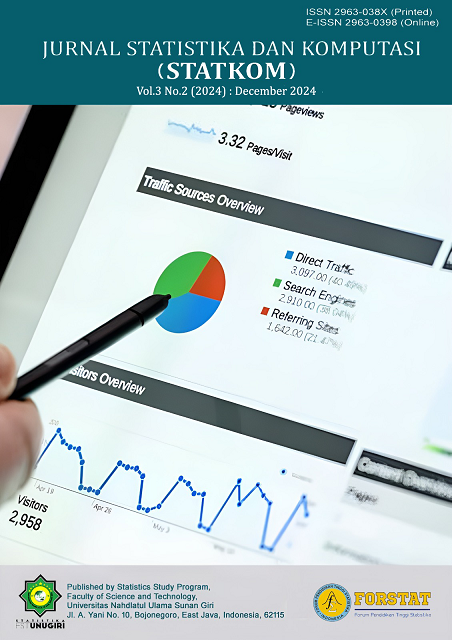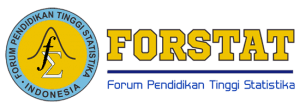Implementasi Metode Seasonal Autoregressive Integrated Moving Average (SARIMA) untuk Memprediksi Curah Hujan di Kota Semarang
 PDF Download: 290
SIMILARITY INDEX Download: 0
PDF Download: 290
SIMILARITY INDEX Download: 0
DOI:
https://doi.org/10.32665/statkom.v3i2.3224Keywords:
Rainfall, Forecasting, MAPE, SARIMAAbstract
Background: Rainfall is one of the important factors that has a significant impact on various aspects of life, especially in urban areas such as Semarang. Significant fluctuations in rainfall can cause flooding, which negatively impacts infrastructure, agriculture, health and well-being of the community. Therefore, accurate rainfall forecasting is essential to support informed decision-making.
Objective: The purpose of this study is to identify and build an optimal SARIMA model for rainfall forecasting in Semarang City.
Methods: This study used the Seasonal Autoregressive Integrated Moving Average (SARIMA) method to analyze the monthly rainfall data of Semarang City for the period 2017-2022, because it was able to handle seasonal patterns in the time series data. The best model is determined based on the Akaike Information Criterion (AIC) value, while the accuracy of the prediction is measured using the Mean Absolute Percentage Error (MAPE) value.
Results: Based on the results of the analysis, the best SARIMA model was SARIMA (1,1,0) (0,1,0)12 because it produced the smallest AIC value (121.67) and MAPE of 41.59%. This model is used to predict rainfall from January 2023 to December 2025.
Conclusion: The SARIMA (1,1,0) (0,1,0)12 model is the best model for rainfall forecasting in Semarang City. The results of this study support previous studies that state that the SARIMA method is effective for rainfall data that have high fluctuations and extreme values.
References
Agyemang, E. F., Mensah, J. A., Ocran, E., Opoku, E., & Nortey, E. N. N. (2023). Time series based road traffic accidents forecasting via SARIMA and Facebook Prophet model with potential changepoints. Heliyon, 9(12), e22544. https://doi.org/10.1016/j.heliyon.2023.e22544
Arnita, A. (2020). Comparison of Single Exponential Smoothing, Naive Model, and SARIMA Methods for Forecasting Rainfall in Medan. Jurnal Matematika, Statistika Dan Komputasi, 17(1), 117–128. https://doi.org/10.20956/jmsk.v17i1.10236
Chang, P.-C., Wang, Y.-W., & Liu, C.-H. (2007). The development of a weighted evolving fuzzy neural network for PCB sales forecasting. Expert Systems with Applications, 32(1), 86–96. https://doi.org/10.1016/j.eswa.2005.11.021
Hillmer, S. C., & Wei, W. W. S. (1991). Time Series Analysis: Univariate and Multivariate Methods. Journal of the American Statistical Association, 86(413), 245. https://doi.org/10.2307/2289741
Huda, A. M., Choiruddin, A., Budiarto, O., & Sutikno, S. (2012). Peramalan Data Curah Hujan dengan Seasonal Autoregressive Integrated Moving Average ( SARIMA ) dengan Deteksi Outlier sebagai Upaya Optimalisasi Produksi Pertanian di Kabupaten Mojokerto. Seminar Nasional : Kedaulatan Pangan Dan Energi, Fakultas Pertanian Universitas Trunojoyo Madura. https://hal.science/hal-01677093/file/PERAMALAN-DATA-CURAH-HUJAN-DENGAN-SEASONAL-AUTOREGRESSIVE-INTEGRATED-MOVING-AVERAGE-SARIMA-DENGAN-DETEKSI-OUTLIER-SEBAGAI-UPAYA-OPTIMALISASI-PRODUKSI-PERTANIAN-DI-KABUPA (1).pdf
Khoiriyah, N. S., Silfiani, M., Novelinda, R., & Rezki, S. M. (2023). Peramalan Jumlah Penumpang Kapal di Pelabuhan Balikpapan dengan SARIMA. Jurnal Statistika Dan Komputasi, 2(2), 76–82. https://doi.org/10.32665/statkom.v2i2.2303
Lusiani, A., & Habinuddin, E. (1970). PEMODELAN AUTOREGRESSIVE INTEGRATED MOVING AVERAGE (ARIMA) CURAH HUJAN DI KOTA BANDUNG. Sigma-Mu, 3(2), 9–25. https://doi.org/10.35313/sigmamu.v3i2.874
Silfiani, M., Hayati, F. N., & Azka, M. (2023). Application of Double Seasonal Autoregressive Integrated Moving Average (DSARIMA) for Stock Forecasting. Jurnal Statistika Dan Komputasi, 2(1), 12–19. https://doi.org/10.32665/statkom.v2i1.1594
Sipayung, S. B., Nurlatifah, A., & Susanti, I. (2019). Proyeksi Neraca Air Di Wilayah Nusa Tenggara Barat ( Ntb ) Berdasarkan Luaran Model Conformal Cubic Atmospheric Model ( Ccam ) ( The Projection Of Water Balance In Nusa Tenggara Barat ( Ntb ) Based On Conformal Cubic Atmospheric Model ( Ccam ) Output ). 79–90. https://jurnal.lapan.go.id/index.php/jurnal_sains/article/view/2966
Wijaya, A. S. (2017). OPTIMASI PARAMETER MODEL SUPPORT VECTOR REGRESSION UNTUK PEMODELAN BEBAN LISTRIK DI EMPAT BELAS WILAYAH DI JAWA TIMUR DENGAN MENGGUNAKAN GENETIC ALGORITHM DAN PARTICLE SWARM OPTIMIZATION [Institut Teknologi Sepuluh November]. https://repository.its.ac.id/47901/
Downloads
Additional Files
Published
How to Cite
Issue
Section
License
Copyright (c) 2024 Asti Ermawati, Ahmad Amrullah, Khoirul Huda, M. Al Haris

This work is licensed under a Creative Commons Attribution-ShareAlike 4.0 International License.
Authors who publish with this journal agree to the following terms:
- Authors retain copyright and grant the journal right of first publication with the work simultaneously licensed under a Creative Commons Attribution License - Share Alike that allows others to share the work with an acknowledgment of the work's authorship and initial publication in this journal.
- Authors are able to enter into separate, additional contractual arrangements for the non-exclusive distribution of the journal's published version of the work (e.g., post it to an institutional repository or publish it in a book), with an acknowledgment of its initial publication in this journal.
- Authors are permitted and encouraged to post their work online (e.g., in institutional repositories or on their website) prior to and during the submission process, as it can lead to productive exchanges, as well as earlier and greater citation of published work.
USER RIGHTS
All articles published Open Access will be immediately and permanently free for everyone to read and download. We are continuously working with our author communities to select the best choice of license options, currently being defined for this journal as follows:
 PDF Download: 290
SIMILARITY INDEX Download: 0
PDF Download: 290
SIMILARITY INDEX Download: 0














